

The simple answer to this question is no. Cattle do not need horns in the majority of modern production management environments, whether that be beef or dairy operations.
The presence of horns in modern animal production systems poses more of a risk than a benefit.
Some of those risks are being hazardous to the health and safety of workers, having a negative impact on the health and welfare of other animals, increasing labor related to handling and restraint for routine tasks, and decreasing overall system efficiency and productivity to name a few.
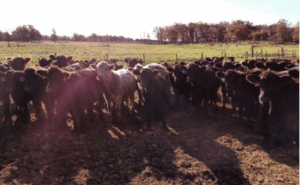
So Doc, if cattle do not need horns, how do you remove the horns from your cattle? There are several different methods.
The easiest method is to utilize genetics in your favor, so horns will not grow on your animal. Specifically, utilizing a polled (non-horn-bearing) bull will produce calves that are polled as the lack of horns is a genetically dominant gene trait (see image 1).
From a growth, development, and welfare perspective, this is the best overall option to not having horned cattle.
Other means of removing horns, particularly surgically, can cause stress, require healing, and can slow growth as the dehorning sites heal.
When trying to maximize efficiency, growth, and overall health of calves, the less stress and healing that must occur, the better off the calves will be.

Some concern about the merit of polled genetics has existed, the theory being that polled cattle would underperform compared to their horned counterparts.
A study comparing the production traits of polled versus horned animals examined 18 years’ worth of data (2000- 2018) across eight common breeds of cattle that both polled and horned genetics exist.
The findings of this study demonstrate that there is no difference in growth and performance metrics and that polled animals outperform horned cattle in certain metrics, especially later in life performance (Comparison of Genetic Merit for Weight and Meat Traits Between the Polled and Horned Cattle in Multiple Beef Breeds, Animals, 2021, 2/18/25).
Not only do polled animals perform as well or better than their horned counterparts, feeding operations typically pay less for horned calves.
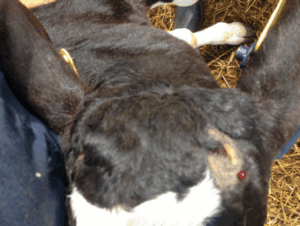
If genetically preventing horns is not a viable option for an operation, there are several techniques available to remove the horns.
A general guideline for these methods is that the earlier they can be performed the better. Within the first couple of weeks of being born, the horn is not fully attached to the head.
Therefore, the first method of managing horned animals is to disbud them. As the name implies, this procedure removes the tissue (horn bud) that the horn would grow from.
This can be done either by hot iron, caustic paste, or a scoop instrument that either damages or removes the horn growth tissue (see image 2).
Once the horn bud tissue attaches to the skull, we have shifted to truly having to dehorn an animal.
Again, the earlier this procedure can be done in life, the better off everyone will be because early removal will help reduce damage to surrounding tissue, help reduce stress associated with the procedure, and decrease risk of complications or prevent illness associated with the procedure.

As cattle horns grow larger, they begin to connect to the sinus cavities of the skull.
When dehorning is performed after these connections have been established, there may not be a viable way to close the sinus.
With the sinus cavity open, foreign objects such as dirt, insects, or other objects can enter the cavity, increasing the risk for infections and complications.
There are various methods and devices available to accomplish dehorning-scoops, hot irons, bone wire, and caustic paste to name a few.
Everyone has their preferred method for the various size horns they encounter and other environmental and management factors.
All techniques have some degree of blood loss and require either a hot iron to cauterize the wounds, twisting the arterial blood supply with small hemostats, or application of a blood stop agent to reduce the amount of blood loss.
As horn diameter increases, the amount of blood loss risk increases. In some locations, suturing the dehorning site closed is necessary to prevent contamination or fly infestations from becoming a problem after the procedure is performed.
Closing the dehorning site can also help decrease blood loss.
This increases the time, technical skill, and aseptic technique required to safely and effectively perform the procedure and reduce the risk of complications.

So that is a brief overview of the how, risks, and a little bit of the why particularly at the cow-calf operation level.
What are the implications once horned animals arrive at the feedlot? When horned animals are received at feeding operations, the opportunity to remove these horns as early in life as possible is no longer possible.
This phase of production is where horned animals can be particularly hazardous to other cattle and humans as the animals are living in closer proximity to each other.
Other cattle can suffer significant injury by horned animals either accidentally or maliciously.
Some wounds may be undetectable, others may be fatal, resulting in the loss of animal life and a valuable protein source.
Wounds that occur late in the feeding period may only be fully appreciated post-harvest as bruising and discoloration that must be trimmed away causing potentially significant losses.
Other wounds may be found when it is significantly too late to intervene, and euthanasia is the only viable option if the animal has not already succumbed to the injury.
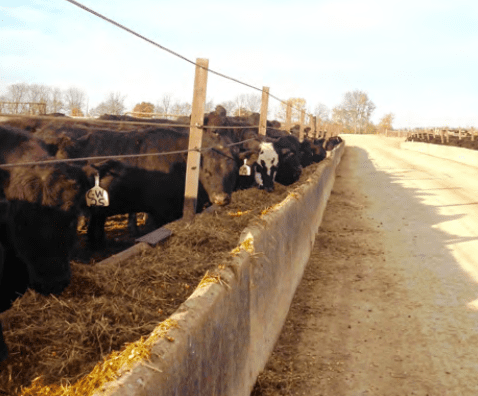
When found and deemed treatable, repair of penetrating horn wounds costs time and resources (veterinary, financial, medicinal, etc.).
Two resources that may be most significantly impacted by injury or illness are time and nutrition, key factors to feed conversion efficiency and financial opportunity.
Anytime cattle experience an injury or illness, part of the nutrition they ingest is placed towards repair and healing of tissues or clearing an infection.
The fewer times we intentionally inflict a wound on cattle such as dehorning, the better off and more efficient the animals are as they dedicate their time and energy on feed towards the growth and production of protein (see image 3).
As previously mentioned, there are various methods of dehorning. From a technique standpoint, some procedures are less detrimental overall to cattle compared to others.
One such study (Effects of Three Dehorning Techniques on Behavior and Wound Healing in Feedlot Cattle, Journal of Animal Science, 2014, pg. 2225-2229, 2/18/25) found that the use of constrictive bands was not only ineffective but also had the most prolonged pain.
True mechanical removal of the horn had an immediate pain component that subsided quicker than constrictive bands.
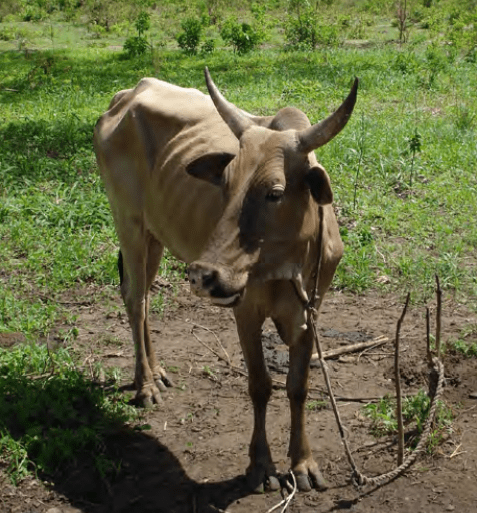
Horns come in all shapes and sizes. Sometimes just working with horned animals in the processing chutes is more difficult and time consuming waiting on the animal to navigate their environment.
Some headgate systems adapt well to horned animals coming through and not causing problems with restraint. Other systems seem to miss the animals entirely as they figure out how to use their horns to prevent appropriate restraint.
There are certain settings or situations where horns are required for protection due to high predation in the environment (see images 4 and 5).
For other breeds, their horns are the commodity being produced.
However, these breeds are not typically great at producing a valuable protein source.
For the producers in the business of providing a protein source efficiently, horns are a liability on the enterprise.
Your local veterinarian can help sort the best method of dehorning your cattle.
As well, your veterinarian can help develop a pain management plan to get the calves back on feed faster and support the animal’s wellbeing.
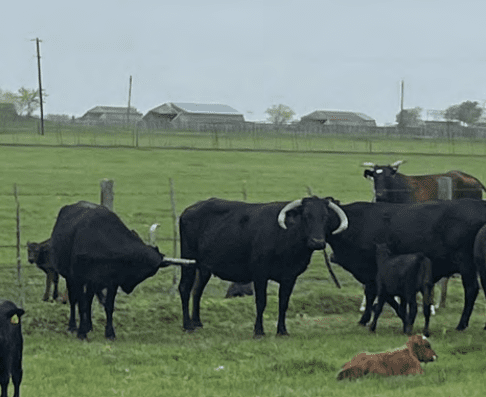
Leverage genetics to your advantage. Use a polled bull so the horns never have a chance.
If genetically dehorning is not an option, dehorning the calves as early in life as possible can reduce the impact the procedure has on the health of the calf.
Do what you must in order to keep horns out of the feedlot. If they come in with horns, figure out the best method of dehorning and managing the animals afterward.
 Brian Shoemake is a 2011 graduate of the University of Tennessee College of Veterinary Medicine. Brian is currently a Clinical Assistant Professor of Food Animal Field Services at Texas A&M University College of Veterinary Medicine & Biomedical Sciences in the Large Animal Teaching Hospital. He previously worked at the University of Missouri College of Veterinary Medicine where he completed his residency training in production medicine and food animal internal medicine. Brian and his wife, Catherine, enjoy time with family and the outdoors.
Brian Shoemake is a 2011 graduate of the University of Tennessee College of Veterinary Medicine. Brian is currently a Clinical Assistant Professor of Food Animal Field Services at Texas A&M University College of Veterinary Medicine & Biomedical Sciences in the Large Animal Teaching Hospital. He previously worked at the University of Missouri College of Veterinary Medicine where he completed his residency training in production medicine and food animal internal medicine. Brian and his wife, Catherine, enjoy time with family and the outdoors.
Get all Doc Talk episodes straight to your email inbox!